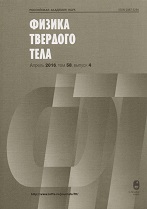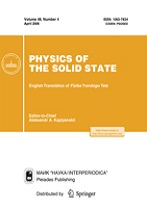|
This article is cited in 16 scientific papers (total in 16 papers)
Impurity centers
Identification of paramagnetic nitrogen centers (P1) in diamond crystallites synthesized via the sintering of detonation nanodiamonds at high pressure and temperature
V. Yu. Osipova, F. M. Shakhova, N. N. Efimovb, V. V. Mininb, S. V. Kidalova, A. Ya. Vul'a
a Ioffe Institute, St. Petersburg
b Kurnakov Institute of General and Inorganic Chemistry, Russian Academy of Sciences, Moscow
Abstract:
Diamond single crystals synthesized from powder detonation nanodiamonds (DNDs) by means of treatment at high pressures ($P$ $\sim$7 GPa) and temperatures ($T>$ 1300$^\circ$C) have been studied by electron paramagnetic resonance (EPR). A key feature of treatment (high-pressure high–temperature (HPHT) sintering) is the use of low molecular weight alcohols in the process. The appearance of a hyperfine EPR signal structure due to “paramagnetic nitrogen” (P1 centers) is explained by the growth of submicron and micron diamond single crystals from DND nanocrystals by the oriented attachment and coalescence mechanism. Such growth and coarsening of crystals appreciably decreases the concentration of paramagnetic centers, the presence of which hinders the detection of a hyperfine structure in the EPR signal from P1 centers, in the near-surface areas of coalesced and grown together DND particles. It has been shown that the concentration of paramagnetic defects of all types decreases to $\sim$3.1 $\times$ 10$^{18}$ g$^{-1}$ ($\sim$60 ppm) during HPHT treatment at $T$ = 1650$^\circ$C. This causes the successful identification of P1 centers, whose fraction is no less than $\sim$40% of the total amount of paramagnetic centers in microcrystals synthesized by HPHT sintering.
Received: 03.10.2016
Citation:
V. Yu. Osipov, F. M. Shakhov, N. N. Efimov, V. V. Minin, S. V. Kidalov, A. Ya. Vul', “Identification of paramagnetic nitrogen centers (P1) in diamond crystallites synthesized via the sintering of detonation nanodiamonds at high pressure and temperature”, Fizika Tverdogo Tela, 59:6 (2017), 1125–1132; Phys. Solid State, 59:6 (2017), 1146–1153
Linking options:
https://www.mathnet.ru/eng/ftt9552 https://www.mathnet.ru/eng/ftt/v59/i6/p1125
|


| Statistics & downloads: |
| Abstract page: | 41 | | Full-text PDF : | 11 |
|





 Contact us:
Contact us: Terms of Use
Terms of Use
 Registration to the website
Registration to the website Logotypes
Logotypes








 Citation in format
Citation in format 
